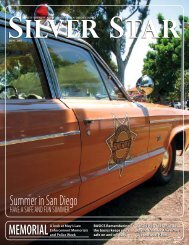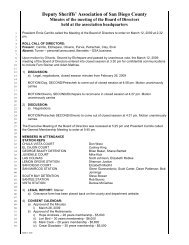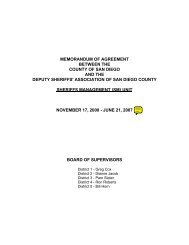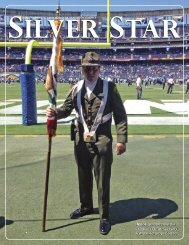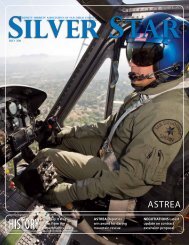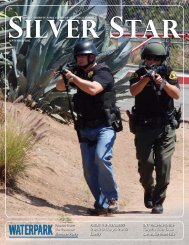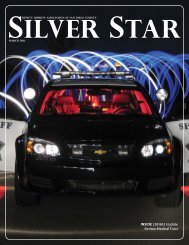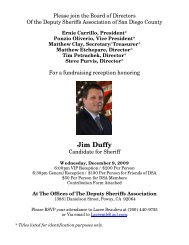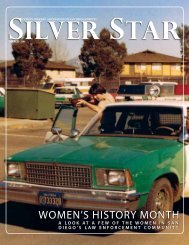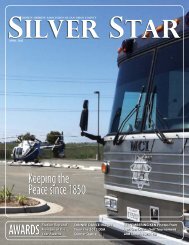MLK PARADE - Deputy Sheriffs' Association of San Diego County
MLK PARADE - Deputy Sheriffs' Association of San Diego County
MLK PARADE - Deputy Sheriffs' Association of San Diego County
You also want an ePaper? Increase the reach of your titles
YUMPU automatically turns print PDFs into web optimized ePapers that Google loves.
Talking Versus Cuffing<br />
The Great Debate About Handcuff and Arrest Warnings<br />
by Dr. Steve Albrecht<br />
There are two schools <strong>of</strong> thought about the actions and words you<br />
should use prior to placing handcuffs on suspects. One approach,<br />
when arresting drunk drivers, for example, says that you tell<br />
the subject, “The last part <strong>of</strong> this field test is for you to put your hands<br />
behind your back and lock your fingers together.”<br />
When the suspect does this, you can step in quickly and slip the<br />
handcuffs over his or her wrists, since they are already in cuffing<br />
position. The element <strong>of</strong> surprise, goes this thinking, will prevent a<br />
struggle, since by the time he or she realizes what is happening, it’s too<br />
late and the cuffs are already on (and in the right position, hopefully).<br />
The other school <strong>of</strong> thought suggests that you communicate your<br />
intended actions: “You did not pass my test. You’re now under arrest for<br />
drunk driving. There is no other choice here. Put your hands behind<br />
your back. Now put the backs <strong>of</strong> your hands together. I’m going to<br />
handcuff you. Do it now and then don’t move. If I feel you move or you<br />
try to fight me, I (and my partner) will stop you. If you fight me, you<br />
will get hurt and I don’t want that. Don’t try to run or do anything that<br />
might make me think you want to hurt me. Do you understand me”<br />
I prefer to live in the second school. Let’s break it down. In the first<br />
scenario, the suspect has a buzz on and his balance and thought<br />
processes are fuzzy. He’s not sure if he has done well on the Field<br />
Coordination Test, but he thinks he still has a good chance <strong>of</strong><br />
talking this deputy out <strong>of</strong> arresting him. This has all been a big<br />
misunderstanding and he just wants to get home, go to bed, and sleep it<br />
<strong>of</strong>f. Suddenly and without knowing why (in his alcohol-addled brain),<br />
he feels handcuffs going on his wrists. He decides now is the time to<br />
have that chat with the deputy about him leaving for home and turns<br />
to start talking. This is accompanied by him saying, lots <strong>of</strong> times, “Hey!<br />
Wait! Let me just say something! Hold on! I’m not drunk and you can’t<br />
do this...”<br />
What follows next is the usual street cha-cha, where uniforms get torn<br />
and suspects and deputies end up in ERs for stitches. And the story his<br />
defense attorney will tell will be the one where he was just standing<br />
there and the deputy suddenly “attacked” him.<br />
In the second school <strong>of</strong> thought, the suspect is told, by you, exactly what<br />
you are doing and, more importantly, what will happen if he tries to<br />
fight. You can write the exact statement you made into your report: “I<br />
told Mr. X that he was under arrest and that he should put his hands<br />
behind his back and not move while I handcuffed him. At that point<br />
he...”<br />
And here is where the suspect makes his own choice: “...complied and I<br />
handcuffed him, searched him for weapons or contraband, and placed<br />
him in my patrol car.” Or he makes another choice: “...refused to follow<br />
my instructions and turned toward me and raised his fists in a way that<br />
meant he wanted to fight me. I grabbed his right wrist and executed<br />
an arm-bar takedown, using the right front hood <strong>of</strong> my patrol car to<br />
control his upper body. I used a wrist-twist technique to put his right<br />
hand into handcuffing position and then applied both handcuffs to his<br />
wrists.”<br />
I believe in the power and the validity <strong>of</strong> the second school <strong>of</strong> arrest and<br />
control because whatever force we use, including deadly force, we can<br />
honestly say, on paper, to our Shooting Review Board, to the media, to<br />
a plaintiff’s lawyer, and to a jury, “I warned him in advance not to fight<br />
me during the arrest process. When he grabbed for my gun, I used an<br />
elbow strike to the side <strong>of</strong> his head, then pulled my duty weapon and...”<br />
However it ends for the suspect, you know in your heart and head that<br />
you explained the forthcoming arrest process (using simple statements<br />
and simple commands) and gave him every chance to comply.<br />
This same theory <strong>of</strong> “Talk First, Cuff Second” can be used for the benefit<br />
<strong>of</strong> any nearby witnesses when you shout at suspects who are resisting.<br />
“Stop fighting! Don’t move! Put your hands behind you, now!”<br />
“The cop told him to stop” is what truthful witnesses will say when<br />
asked by detectives, the news media, or a lawyer. And while we don’t say<br />
“drop the gun” to crooks who are already pointing it at us, so they can<br />
shoot us first (this isn’t the movies); we can give commands that tell all<br />
who hear us that we will shoot if they choose to reach for a weapon.<br />
Talking doesn’t always work in every situation. Sometimes you have<br />
to act first (and fast) then talk later, but if you make it a part to explain<br />
while you detain, you can change the ways suspects respond to the<br />
arrest process. <br />
***<br />
Steve Albrecht worked for the SDPD from 1984 to 1999. His police books include<br />
Streetwork; Surviving Street Patrol; and his latest, Tactical Perfection for Street<br />
Cops, which are all available from www.paladin-press.com. He can be reached at<br />
steve@contactandcover.com.<br />
Buying Selling Investing<br />
Search all <strong>San</strong> <strong>Diego</strong> <strong>County</strong> Homes for Sale at<br />
www.YourDarlingRealtor.com<br />
Current 30 Year Fix as<br />
LOW as 4.75%!!<br />
Loan Amount = Payment/Month<br />
$150,000 = $782.47<br />
$200,000 = $1,043.29<br />
$250,000 = $1,304.11<br />
$300,000 = $1,564.94<br />
$350,000 = $1,825.76<br />
$400,000 = $2,086.59<br />
$425,000 = $2,217.00<br />
• Conventional, FHA, and VA<br />
• Jumbo Loans as low as 5%<br />
• $0 Down USDA program available<br />
• Hud Approved - Good Neighbor<br />
Next Door Program available<br />
Call or Email<br />
to take advantage <strong>of</strong><br />
these FREE services<br />
• Free Home Value Analysis with<br />
comparative market data provided<br />
• Free Mortgage Consultation<br />
for purchasing, refinancing, or<br />
investment rates<br />
• Free list <strong>of</strong> properties gauged to<br />
your specific desires and criteria<br />
• Free 15 min phone consultation<br />
with 1031 tax deferred<br />
exchange accommodator<br />
YOUR REALTOR & EXECUTIVE MORTGAGE CONSULTANT<br />
STEVEN DARLING<br />
619-504-9983 direct<br />
SDarling@RealtyExecutives.com<br />
LICENSE # 01383804 NMLS # 237274<br />
Realty Executives All Area – 3773 Willow Glen Dr. #100, El Cajon, Ca 92019 DRE Broker #01853235, All terms and APR are subject to change<br />
Silver Star February 2011 21



